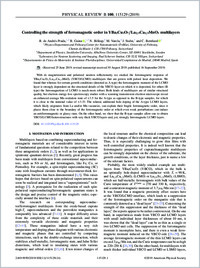Controlling the strength of ferromagnetic order in YBa2Cu3O7/La2/3Ca1/3MnO3 multilayers
- Andrés Prada, Roberto de Physics Department and Fribourg Center for Nanomaterials (FriMat), University of Fribourg, Chemin du Musée 3, CH-1700 Fribourg, Switzerland
- Gaina, Roxana Physics Department and Fribourg Center for Nanomaterials (FriMat), University of Fribourg, Chemin du Musée 3, CH-1700 Fribourg, Switzerland
- Biškup, N. Departamento de Física de Materiales and Instituto Pluridisciplinar, Universidad Complutense de Madrid, 28040 Madrid, Spain
- Varela, M. Departamento de Física de Materiales and Instituto Pluridisciplinar, Universidad Complutense de Madrid, 28040 Madrid, Spain
- Stahn, J. Laboratory for Neutron Scattering and Imaging, Paul Scherrer Institut, CH-5232 Villigen, Switzerland
- Bernhard, Christian Physics Department and Fribourg Center for Nanomaterials (FriMat), University of Fribourg, Chemin du Musée 3, CH-1700 Fribourg, Switzerland
-
16.09.2019
Published in:
- Physical Review B. - 2019, vol. 100, no. 11, p. 115129
English
With dc magnetization and polarized neutron reflectometry we studied the ferromagnetic response of YBa2Cu3O7/La2/3Ca1/3MnO3 (YBCO/LCMO) multilayers that are grown with pulsed laser deposition. We found that whereas for certain growth conditions (denoted as A type) the ferromagnetic moment of the LCMO layer is strongly dependent on the structural details of the YBCO layer on which it is deposited, for others (B type) the ferromagnetism of LCMO is much more robust. Both kinds of multilayers are of similar structural quality, but electron energy-loss spectroscopy studies with a scanning transmission electron microscope reveal an enhanced average Mn oxidation state of +3.5 for the A-type as opposed to the B-type samples, for which it is close to the nominal value of +3.33. The related, additional hole doping of the A-type LCMO layers, which likely originates from La and/or Mn vacancies, can explain their fragile ferromagnetic order, since it places them close to the boundary of the ferromagnetic order at which even weak perturbations can induce an antiferromagnetic or glassy state. On the other hand, we show that the B-type samples allow one to obtain YBCO/LCMO heterostructures with very thick YBCO layers and, yet, strongly ferromagnetic LCMO layers.
- Faculty
- Faculté des sciences et de médecine
- Department
- Département de Physique
- Language
-
- English
- Classification
- Physics
- License
- License undefined
- Identifiers
-
- RERO DOC 327111
- DOI 10.1103/PhysRevB.100.115129
- Persistent URL
- https://folia.unifr.ch/unifr/documents/308271
Statistics
Document views: 67
File downloads:
- ber_csf.pdf: 136
